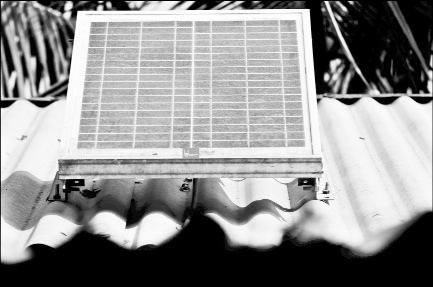 — Photo © Habib Torikul
— Photo © Habib Torikul A spark of light came from south corner of a muddy house early that evening. Above a wooden table different colourful books and khatas were scattered. Eight years old Lata sat under the solar lamp with her school books and was busy doing homework for the next day. Her exams were supposed to come in the later week. Her mother Aklima Khatun (35) was busy with vegetables garden which is a bit far from her house. Aklima came back with about a yard long bottle gourd in her hand and a rarest trace of smile in the face. After initial introduction she warmly welcomed us and started to talk. Following her experience, I asked her quite enthusiastically, what are the benefits of solar energy? With a trace of smile Lata's mother Aklima Khatun (35) said: "It's not just a light but a light of hope. For many years I had been asking my husband to buy a solar but he couldn't, because my husband works as a day labourer and it would take Tk 20,000 which is beyond his capacity." Yet indeed her dreams were not shattered. Children are doing more homework. Having a solar light means that light is always available.
Anthropogenic greenhouse gas emissions, especially carbon, have had a significant as well as negative impact for climate change (Hughes 2000). Effects of increased warming from greenhouse gas emissions include rising ocean temperatures and sea levels, a change in global precipitation patterns, and melting glaciers (Ibrahim 2000, Hughes 2000). Carbon accounts for 80% of all the greenhouse gas emission contributions to global warming (Lashof and Ahuja 1990). It is assumed that carbon dioxide will cause more than half of the climate change that will occur over the contemporary century. One of the most recognizing ways to reduce carbon emissions is to mitigate fossil fuel electricity production by using renewable energy instead. For example, a residential solar panel system has the aptitude to cover the electricity needs of an entire home with about 80% lower carbon emissions than fossil fuels. To address this issue, Islamic Relief Bangladesh adopted low-cost adaptation and mitigation approaches including solar plants introduced in the communities through small scale demonstrative initiatives by implementing project titled "Program for Augmenting Disaster Risk Reduction and Climate Change Adaptation Capacity of the Communities in the South-western Bangladesh" in Assasuni upazila under Satkhira district and Koyra upazila under Khulna district.
Due to climate change and attacks of two consequent super cyclones these project areas are highly poverty-stricken and vulnerable. In project areas rural electrification through Solar Home System is becoming more popular day by day not only considering electricity but also as a means of low cost adaptation and mitigation approaches against climate change and disasters. It presents an attractive alternative to conventional electricity and climate change issue such as carbon reduction, no monthly bills, no fuel cost, little repair and maintenance costs, easy to install any where etc. Solar Home Systems have already made significant headway here. A total of 750 solar panels and Solar Lanterns have been installed in as many households. By using solar energy communities improve their social condition through education, light up their homes, run televisions, radios, cassette players, charge mobile phones etc. This also builds a sense of ownership and technology transfer. It allows students to continue their study even after darkness.
Islamic Relief Bangladesh believes that use of solar energy is enhancing way for the country to support adaptation and development, representing a more ecological mitigation pathway with accent on the preamble and use of clean and resource-efficient technologies along with social and environmental sustainability and improved social equity.
The writer works at Islamic Relief Bangladesh and can be reached at email : [email protected]
© 2024 - All Rights with The Financial Express
